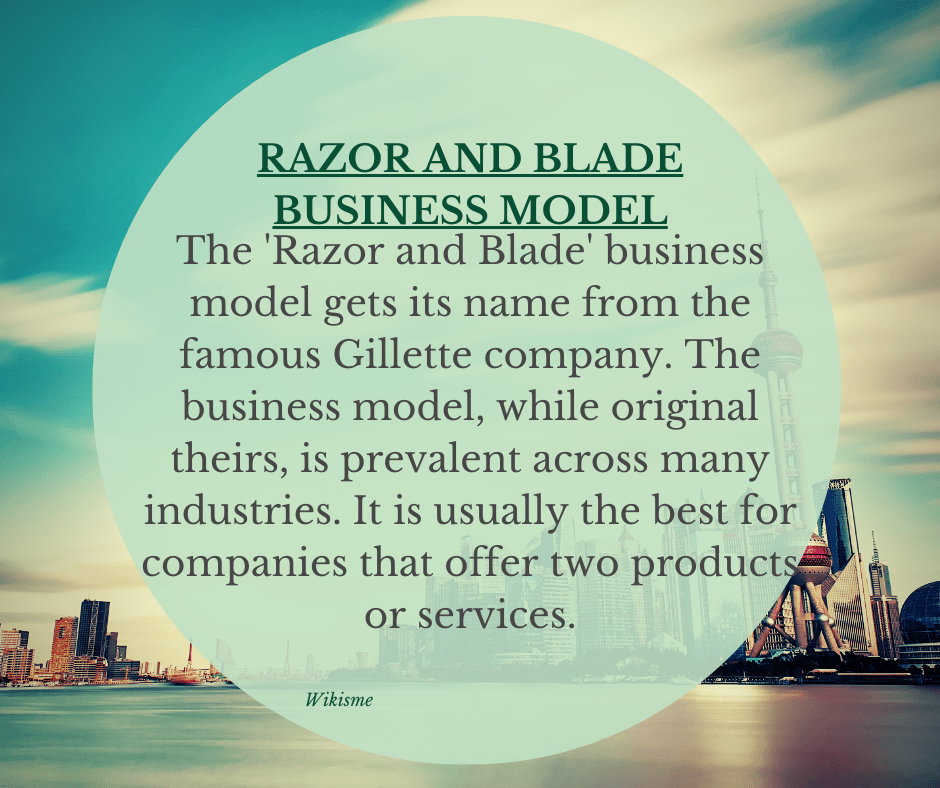The ‘Razor and Blade’ business model comes from the famous Gillette company. The business model, while originally theirs, is prevalent across many industries. It is usually the best for companies that offer two products or services.

What is the Razor and Blade business model?
The razor and blade business model is for companies that sell two products or services that are complementary and interdependent. In the equation, one product or service is the razor, while the other is the blade. The razor is a product that needs the blade product to function.
However, the blade is a disposable product that customers must renew regularly. Therefore, the company sells its razor product for lower prices while generating its primary revenues from the blade product.
The business model comes from Gillette, which sells two products, a razor, and a blade. The company realized that a disposable razor blade is not convenient.
Therefore, it started selling solid razors while keeping the prices substantially low. Instead, the company earned its income through its blades. The decrease in the prices of razors increases the demand for blade products.
In today’s modern world, most companies use a combination of two interdependent products to create the same effect. The model is popular among various companies that use it to generate earnings.
While they don’t use a similar strategy, companies have started varying the business model to their advantage. Some companies offer various razors or blades to sweeten the deal for customers.
How does the Razor and Blade business model work?
The razor and blade business model come from companies that manufacture products or provide services that go together. A company that utilizes this model decreases the price of one of its products, often the primary product that depends on the other function.
The company makes a decent margin for the other product to cover the razor product’s lower prices.
The razor product in this business model is usually a product or service that is solid or fixed. Customers need to invest in it for one time and keep using it for a long time.
However, the razor does not function without the blade. Therefore, the company understands that the primary profits lie in the blade, not the razor.
As mentioned, the bladed product in this business model is the primary revenue source for the company. A company selling its razor product relies on the blade to generate earnings.
Therefore, most companies keep their razor and blade products separate to benefit long-term. Through their blade products, companies can establish a steady and stable source of income.
What are the advantages and disadvantages of the Razor and Blade business model?
The razor and blade business model can be beneficial and disadvantageous for companies. Some of its main advantages and disadvantages consist of the following.
Advantages
Companies can generate a steady and stable source of income through their blade products. They don’t get limited to offering their razor products only. Therefore, these companies may make more money than if they only sold their razor products.
The business model also works for almost any industry. Therefore, any company that offers complementary products can use this. The freemium business model is a variation of the razor and blade business model.
For customers, the razor and blade business model is also beneficial. They don’t have to pay a high premium on razor products, which are generally more expensive. Instead, they can purchase a product one-time and continue using it by renewing the blade product.
Disadvantages
Companies that utilize this business model face the threat of competition, especially for their supplementary blade products. Since the companies rely on their blade products to generate earnings, it can’t be profitable if a competitor takes over the same market. Companies may use patents or trademarks to limit competition.
However, for established markets, competition can be vital.
Customers can also face a threat from companies with a monopoly in these markets. Some companies have exploited customers into paying more than the premium prices for their products. Since customers purchase razor products, they are also held captive to using overpriced blade products.
Examples
HP is the best modern-day example of a company using the razor and blade business model. The company sells printers for a relatively low price.
However, it makes money from selling customers ink and cartridge for its printers, the blade product. Other companies that use the business model are Epson, EA, Sony (PlayStation), Microsoft (Xbox), etc.
Conclusion
The razor and blade business model is for companies that use complementary products that depend on each other. These companies sell their primary product, the razor, for low prices.
However, they still profit from their blade products, which the razor products need to function.